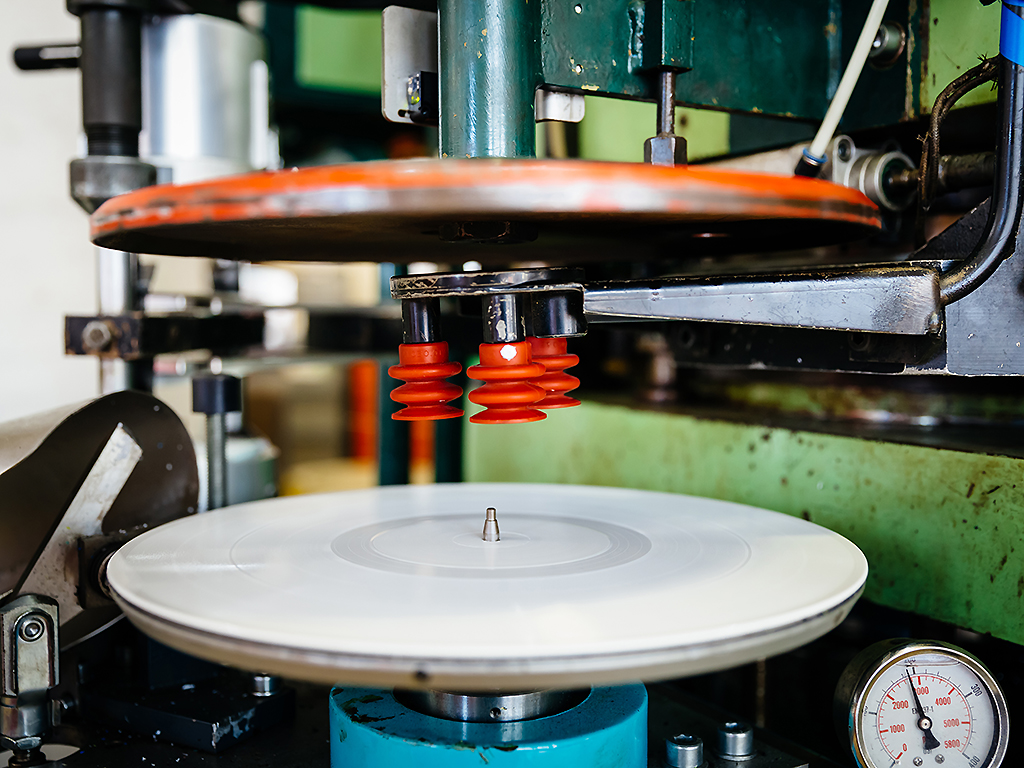When the CD seemed to be on an unstoppable ascent in the 1990s, vinyl pressing plants started shutting down. A few survived, sustained by DJs and turntablists who insisted on doing things the old way, along with a few analogue purists. Even then, these factories struggled with keeping their ancient equipment running. Finding parts grew increasingly difficult and even if you could find them (usually by cannibalizing other gear), who was going to carry out the repairs?

But then, against all odds, interest in vinyl was rekindled after the establishment of Record Store Day in 2008. Since then, countries all over the world have seen double-digit year-over-year demand for new vinyl records.
The old pressing plants began to run flat out. Mothballed plants were brought back online. New facilities were opened. Companies, like Viryl Technologies of Toronto, began manufacturing brand new state-of-the-art pressing machines and exporting them to facilities around the world. Times were good.
But then came a fire in Banning, Calif., the morning of Feb. 6. A three-alarm blaze that began in the chemical mixing area of the 15,000-square-foot Apollo Masters factory took 82 firefighters hours to bring under control. Black smoke billowed high into the sky. People were evacuated from the surrounding areas.
The facility was pretty much destroyed. The owners have no idea when (or even if) they will be able to reopen. The cause of the fire is still under investigation.

Get daily National news
So what does this have to do with the popularity of vinyl? Everything, as it turns out.
Once music destined for vinyl has been recorded, it needs to be transferred to something known as a “master lacquer disc,” a round slab of aluminum coated with lacquer (think shellac or something similar). As the audio is fed into the cutter machine (it looks like a combination turntable and lathe), a stylus — the cutter head — etches the grooves in a smooth spiral into the disc, resulting in something that looks very much like a finished vinyl record. Each side of an album will require its own lacquer plate.
This master master disc is then coated with a mixture of metals (silver, nickel and maybe a few others) through a process called electroplating to produce a “metal master,” which is a tough mirror image of the lacquer disc. It’s this metal plate that’s used to stamp out vinyl records on a pressing machine. This is the way records have been made for decades.
Here’s the problem. Apollo was one of only two factories in the entire world producing lacquer masters. In fact, Apollo was responsible for providing about 80 per cent of the planet’s blank masters. The company was also the only one making and supplying a particular kind of cutter stylus.
The other factory, the much smaller MDC of Japan, was already under insane stress due to high demand before the fire and won’t be able to pick up the slack.
The fire instantly created a vinyl manufacturing crisis. No blank lacquer masters, no master plates. No master plates, no vinyl. Billboard called this “Vinylgeddon.”
The entire vinyl production industry is now freaking out, worried that it will be forced to scale way back or shut down altogether. Best-case scenarios have fresh vinyl orders being fulfilled in six to nine months.
Record labels, artists, mastering engineers, record stores — everyone and everything that’s part of the chain that gives us vinyl records — are very, very concerned. So much for predictions that vinyl sales would burst through the US$1-billion mark for the first time in 40 years. The only winners in all this? Shops selling used records, record stores and online sellers.
There is another way to make a metal master, but it’s tricky and expensive.
There’s also a process called direct metal mastering (DMM), a technology that emerged in the 1980s. It creates master stampers in a slightly different way.
A lathe loaded with a diamond stylus carves grooves into a master disc made of copper, bypassing the need for a lacquer-covered disc. The problem is that DMM equipment is expensive and few companies made the necessary capital investments.
The last American DMM plant, New York-based Europadisk, closed down in 2005, selling its gear to — the Church of Scientology. A couple of DMM companies still operate in Europe. Their phones are probably melting down.
So it’s not entirely hopeless. The vinyl industry was almost wiped out once before and managed to bounce back. But it could be rough for a while.
—
Alan Cross is a broadcaster with Q107 and 102.1 the Edge and a commentator for Global News.
Subscribe to Alan’s Ongoing History of New Music Podcast now on Apple Podcast or Google Play










Comments